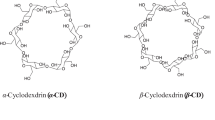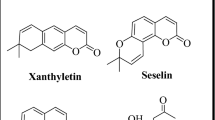Abstract
A rhodamine-based chemosensor for naked-eye detection of Cu2+ has been designed and synthesized, which exhibited excellent selectivity and high sensitivity for Cu2+ in CH3CN and CH3CN/H2O mixed solutions. When Cu2+ was added to the solution of sensor 1, a dramatic color change from colorless to bluish violet was observed, while the cations K+, Ca2+, Na+, Hg2+, Zn2+, Co2+, Ni2+, Fe3+, Al3+, Pb2+, Ag+, and Cd2+ did not interfere with the recognition process for Cu2+. The pH effect investigations indicated that it can be applied to analysis of samples over a wide pH range.









Similar content being viewed by others
References
A.P. DeSilva, H.Q.N. Gunaratne, T. Gunnlaugsson, A.J.M. Huxley, C.P. McCoy, J.T. Rademacher, T.E. Rice, Signaling recognition events with fluorescent sensors and switches. Chem. Rev. 97, 1515–1566 (1997)
R. Martinez-Manez, F. Sancenon, Fluorogenic and chromogenic chemosensors and reagents for anions. Chem. Rev. 103, 4419–4476 (2003)
A.B. Descalzo, R. Martinez-Manez, R. Radeglia, K. Rurack, J. Soto, Coupling selectivity with sensitivity in an integrated chemosensor framework: design of a Hg2+-responsive probe, operating above 500 nm. J. Am. Chem. Soc. 125, 3418–3419 (2003)
A.P. de Silva, D.B. Fox, A.J.M. Huxley, T.S. Moody, Combining luminescence, coordination and electron transfer for signaling purposes. Coord. Chem. Rev. 205, 41–57 (2000)
U.E. Spichiger-Keller (ed.), Chemical sensors and biosensors for medical and biological applications (Wiley-VCH, Weinheim, 1998)
A.W. Czarnik (ed.), Fluorescent chemosensors for Ion and molecular recognition (American Chemical Society, Washington, DC, 1993)
P.B. Tchounwou, W.K. Ayensu, N. Ninashvili, D. Sutton, Environmental exposure to mercury and its toxicopathologic implications for public health. Environ. Toxicol. 18, 149–175 (2003)
M. Angelova, S. Asenova, V. Nedkova, R. Koleva-Kolarova, Copper in the human organism. Trakia J. Sci. 9, 88–89 (2011)
R. Uauy, M. Olivares, M. Gonzalez, Essentiality of copper in humans. Am. J. Clin. Nutr. 67, 952S–959S (1998)
N.J. Robinson, D.R. Winge, Copper metallochaperones. Ann. Rev. Biochem. 79, 537–562 (2010)
D.J. Thiele, J.D. Gitlin, Assembling the pieces. Nat. Chem. Biol. 4, 145–147 (2008)
A. Mathie, G.L. Sutton, C.E. Clarke, E.L. Veale, Zinc and copper: pharmacological probes and endogenous modulators of neuronal excitability. Pharmacol. Ther. 111, 567–583 (2006)
E. Madsen, J.D. Gitlin, Copper and iron disorders of the brain. Ann. Rev. Neurosci. 30, 317–337 (2007)
T. Hirayama, G.C. Van de Bittnera, L.W. Gray, S. Lutsenko, C.J. Chang, Near-infrared fluorescent sensor for in vivo copper imaging in a murine Wilson disease model. Proc. Natl. Acad. Sci. 109, 2228–2233 (2012)
J.S. Valentine, P.J. Hart, Misfolded CuZnSOD and amyotrophic lateral sclerosis. Proc. Natl. Acad. Sci. USA 100, 3617–3622 (2003)
C. Vulpe, B. Levinson, S. Whitney, S. Packman, J. Gitschier, Isolation of a candidate gene for Menkes disease and evidence that it encodes a copper-transporting ATPase. Nat. Genet. 3, 7–13 (1993)
S.G. Kaler, ATP7A-related copper transport diseases-emerging concepts and future trends. Nat. Rev. Neurol. 7, 15–29 (2011)
Y.H. Hung, A.I. Bush, R.A. Cherny, Copper in the brain and Alzheimer’s disease. J. Biol. Inorg. Chem. 15, 61–76 (2010)
J.C. Lee, H.B. Gray, J.R. Winkler, Copper binding to a-synuclein, the Parkinson’s protein. J. Am. Chem. Soc. 130, 6898–6899 (2008)
A.K. Jain, R.K. Singh, S. Jain, J. Raisoni, Copper(II) ion selective electrode based on a newly synthesized schiff-base chelate. Transition Met. Chem. 33, 243–249 (2008)
S.L. Belli, A. Zirino, Behavior and calibration of the copper(II) ion-selective electrode in high chloride media and marine waters. Anal. Chem. 65, 2583–2589 (1993)
M.Y. Pamukoglu, F. Kargi, Elimination of Cu2+ toxicity by powdered waste sludge (PWS) addition to an activated sludge unit treating Cu2+ containing synthetic wastewater. J. Hazard. Mater. 148, 274–280 (2007)
P.G. Welsh, J. Lipton, C.A. Mebane, J.C.A. Marr, Influence of flow-through and renewal exposures on the toxicity of copper to rainbow trout. Eco Toxicol. Environ. Safe. 69, 199–208 (2008)
K.N. Buck, J.R.M. Ross, A.R. Flegal, K.W. Bruland, A review of total dissolved copper and its chemical speciation in San Francisco Bay, California. Environ. Res. 105, 5–19 (2007)
E. Van Genderen, R. Gensemer, C. Smith, R. Santore, A. Ryan, Evaluation of the biotic ligand model relative to other site-specific criteria derivation methods for copper in surface waters with elevated hardness. Aquat. Toxicol. 84, 279–291 (2007)
P. Kumar, R.K. Tewari, P.N. Sharma, Modulation of copper toxicity-induced oxidative damage by excess supply of iron in maize plants. Plant Cell Rep. 27, 399–409 (2008)
J. Huang, Y. Xu, X. Qian, A red-shift colorimetric and fluorescent sensor for Cu2+ in aqueous solution: unsymmetrical 4,5-diaminonaphthalimide with N-H deprotonation induced by metal ions. Org. Biomol. Chem. 7, 1299–1303 (2009)
Z. Guo, W. Zhu, H. Tian, Hydrophilic copolymer bearing dicyanomethylene-4H-pyran moiety as fluorescent film sensor for Cu2+ and pyrophosphate anion. Macromolecules 43, 739–744 (2010)
Y. Hu, Q. Li, H. Li, Q. Guo, Y. Lua, Z. Li, A novel class of Cd2+, Hg2+ turn-on and Cu2+, Zn2+ turn-off Schiff base fluorescent probes. Dalton T. 39, 11344–11352 (2010)
J. Liu, Y. Lu, Colorimetric Cu2+ detection with a ligation DNAzyme and nanoparticles. Chem. Commun. 46, 4872–4874 (2007)
S.J. Lee, S.S. Lee, J.Y. Lee, J.H. Jung, A functionalized inorganic nanotube for the selective detection of copper (II) Ion. Chem. Mater. 18, 4713–4715 (2006)
R. Sheng, P. Wang, Y. Gao, Y. Wu, W. Liu, J. Ma et al., Colorimetric test kit for Cu2+ detection. Org. Lett. 10, 5015–5018 (2008)
S. Basurto, O. Riant, D. Moreno, J. Rojo, T. Torroba, Colorimetric detection of Cu2+ cation andacetate, benzoate, and cyanide anions by cooperative receptor binding in new a, a‘-Bis-substituted Donore-Acceptor Ferrocene Sensors. J. Org. Chem. 72, 4673–4788 (2007)
M. Schmittel, H.W. Lin, Quadruple-channel sensing: a molecular sensor with a single type of receptor site for selective and quantitative multi-ion analysis. Angew. Chem. Int. Edit. 46, 893–896 (2007)
Q. Li, M. Peng, N. Li, J.G. Qin, Z. Li, New colorimetric chemosensor bearing naphthalendiimide unit with large blue-shift absorption for naked eyes detection of Cu2+ ions. Sens. Actuators B 173, 580–584 (2012)
N.R. Chereddy, T. Sathiah, Synthesis of a highly selective bis-rhodamine chemosensor for naked-eye detection of Cu2+ ions and its application in bio-imaging. Dyes Pigm. 91, 378–382 (2011)
J.M. Kwon, Y.J. Jang, Y.J. Lee, K.M. Kim, M.S. Seo, W. Nam et al., A highly selective fluorescent chemosensor for Pb2+. J. Am. Chem. Soc. 127, 10107–10111 (2005)
M.H. Lee, J.S. Wu, J.W. Lee, J.H. Jung, J.S. Kim, Highly sensitive and selective chemosensor for Hg2+ based on the rhodamine fluorophore. Org. Lett. 9, 2501–2504 (2007)
S.K. Ko, Y.K. Yang, J. Tae, I. Shin, In vivo monitoring of mercury ions using a rhodamine-based molecular probe. J. Am. Chem. Soc. 128, 14150–14155 (2006)
K. Ghosh, T. Sarkar, A. Samadderb, A.R. Khuda-Bukhsh, Rhodamine-based bis-sulfonamide as a sensing probe for Cu2+ and Hg2+ ions. New J. Chem. 36, 2121–2127 (2012)
L. Wang, J. Yan, W. Qin, W. Liu, R. Wang, A new rhodamine-based single molecule multianalyte (Cu2+, Hg2+) sensor and its application in the biological system. Dyes Pigm. 92, 1083–1090 (2012)
Acknowledgment
This study was supported by the self-innovation project for universities and institutes of Jinan City (No. 201202035).
Author information
Authors and Affiliations
Corresponding author
Electronic supplementary material
Below is the link to the electronic supplementary material.
Rights and permissions
About this article
Cite this article
Zhang, D., Ma, Y. & An, R. New colorimetric chemosensor based on rhodamine hydrazide to detect Cu2+ ions by naked eye. Res Chem Intermed 41, 5059–5069 (2015). https://doi.org/10.1007/s11164-014-1588-7
Received:
Accepted:
Published:
Issue Date:
DOI: https://doi.org/10.1007/s11164-014-1588-7




